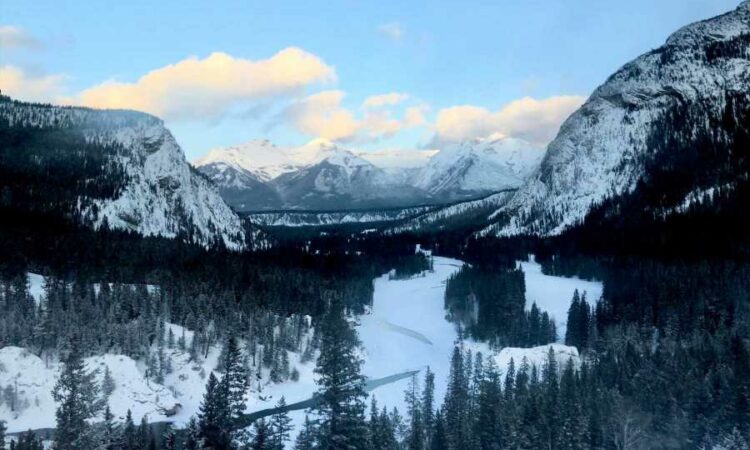Steam drifted up in tufts, blurring the snow-covered fir trees and imposing mountains in the distance. I had been sitting in a small hot tub for far longer than I planned, mesmerized by the view. I stretched my arms out to play with the snow that had fallen on the ground just above the water’s edge. My fingers turned to raisins long ago, but I didn’t mind. I had been in Alberta for just under a week and its laid-back attitude had started to rub off.
I was enveloped by the kind of quiet that comes with heavy snow, and was happy to spend the afternoon taking in views of the castle-like turrets from the hot tub at the Fairmont Banff Springs.
Load Error
My trip, planned just before the COVID-19 pandemic halted travel around the world, was a reminder of the importance of slow travel, really soaking in the beauty of a destination. And there was no shortage of stunning sights in Alberta.
Canada remains closed to much of the world, with hotel quarantine restrictions, land border closures, and extended cruise bans in place. But the winter of 2022 is still a while off, and the world may look quite different by the time snow starts falling on this beautiful province again, making now the perfect time to plan your getaway.
The province of Alberta sits just north of Montana in western Canada, boasting unparalleled views of the Canadian Rockies and breathtaking drives like the Icefields Parkway, where glaciers and frozen trees envelop you like a wintry dream you don’t want to wake up from.
Tourists flock to Alberta’s national parks in every season, but there are far fewer visitors come winter. Jasper National Park, for example, receives about 2.2 million tourists each year, but winter sees just over 156,000 of them, according to Travel Alberta. Summer, on the other hand, brings over 1.1 million visitors to the park.
And while Banff saw over four million visitors as of 2019, only 539,000 of them visited from December through February, compared to over 1.6 million who came in the summer months of June, July, and August.
Gallery: Stunning photos from Utah’s Mighty 5 national parks (USA TODAY)
On one particularly cold day, I stared down into the cascading depths of Maligne Canyon, a torrent of ice frozen mid rush. It felt as if ours was the only group in Jasper. That wasn’t true, of course, but rather than the sounds of tourists bounding toward us, we heard near silence. Later, driving around the park, looking for telltale signs that elk had passed through the thick layers of snow, I was thankful I came as cold had descended.
“The scenes are different every day — it all depends how cold it is, whether it’s snowing, or the sun is out. In Jasper, I call it small-town living — we’ve got all the beautiful winter recreational activities and we’re not really busy and crowded during that time period,” Wesley Bradford, an interpretive adventure guide for the SunDog Tour Co., told me as he drove us around the national park.
“We’re a laid-back, beautiful mountain town with lots of winter recreational activities.”
Bradford started working for the company when he retired in 2014, after 37 years as a wildlife and bear management specialist and park warden for Parks Canada. His expertise is so extensive, he was even asked to share his knowledge with Queen Elizabeth II when she visited in 2005.
Bradford was quick to point out the benefits of coming in the summer — wildflowers, bears in the valley — but no matter how many activities he listed, he couldn’t quite convince me there was a more beautiful time to visit as I stared out at the icy landscape.
We had started our trip in Vancouver, hopping on The Canadian train, a throwback to the days when rail travel was about more than just getting from point A to B. The stainless steel 1950s-style dining car evoked the romance of a time when the journey equally important as the destination. While the train, operated by Via Rail, has 11 sleeper cars in the summer and up to five dome viewing cars, the winter tends to slow down.
Waking up in the cozy private bedroom — inside one of only four sleeper cars — I got my first taste of the wintry terrain: snow-covered trees zooming past the large window as the sun started to rise, bathing everything in a deep, blue light.
“It’s all about how people want to travel nowadays,” Marty Duclos, who has worked for Via for over a decade, told me as he manned the bar in the first-class Prestige lounge the night before. “You get to see the country instead of airport to airport.”
And while you can ride the train from Vancouver to Toronto, there are must-see destinations the train doesn’t quite reach, including Banff. That’s when Vacations by Rail took over, planning the logistics of a land extension, so passengers could focus on the views and spotting as many animals as possible. (Perhaps unsurprisingly, Vacations by Rail’s top three most popular winter itineraries all pass through the Rockies).
After a week spent layering up, gazing out at impossibly beautiful scenery and trying not to fall while ice skating on frozen Lake Louise, I clipped into a pair of skis at the top of a run at Banff Sunshine Village, ready to set off through perfect powder. Snow-covered mountains rose up all around me, and as I pulled my goggles down, I smiled, thrilled that I had the chance to glimpse this gorgeous winter wonderland.
Alison Fox is a contributing writer for Travel + Leisure. When she’s not in New York City, she likes to spend her time at the beach or exploring new destinations and hopes to visit every country in the world. Follow her adventures on Instagram.
Source: Read Full Article

